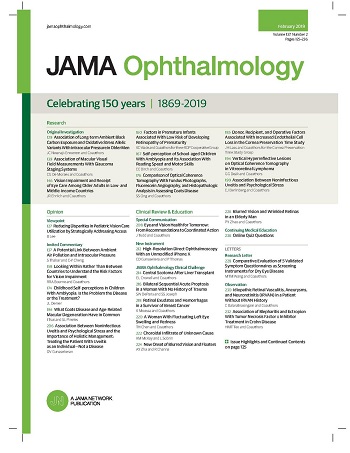与法尼单抗相关的无菌眼内炎
IF 7.8
1区 医学
Q1 OPHTHALMOLOGY
引用次数: 0
摘要
重要性进行随机临床试验是为了确定药物的安全性和有效性。然而,在临床实践中与这些药物相关的不良事件证据,即使不能确定因果关系,也能对不太常见的安全性问题提出有价值的假设。目的介绍并分析转诊至欧洲一家机构的患者中与法替单抗治疗相关的眼内炎病例。患者来自瑞士的一家学术性三级转诊中心。分析对象包括2022年6月1日至2024年3月5日期间因接受法利单抗玻璃体内注射后不久出现眼内炎症而转诊的患者。暴露法利单抗,6毫克(120毫克/毫升溶液的0.05毫升),用于治疗新生血管性年龄相关性黄斑变性或糖尿病性黄斑水肿。评估内容包括:事件发生前后使用糖尿病视网膜病变早期治疗研究图表进行习惯性矫正测量的视力;眼压;患者症状;眼内炎症的前部、中部或后部位置;以及是否存在视网膜血管炎。结果 22 个月内共有 7 名患者的 12 只眼睛(平均 [SD] 年龄 73.3 [16.7] 岁;4 名女性 [57.1%])在玻璃体内注射法尼单抗后出现非感染性眼内炎症。在这些病例中,有两只眼睛的视网膜血管炎与前后炎症同时存在。其中一只眼睛的动静脉血管炎呈闭塞性,导致黄斑毛细血管灌注不全,视力从 20/80 下降到 20/2000,出现不可逆的临床症状。其余患者的眼部特征为中度前段炎症,视力无明显变化。眼内炎症事件发生在法尼单抗注射中位数(IQR)为 3.5(2.0-4.3)次之后。最后一次注射法尼单抗与炎症确诊之间的中位(IQR)间隔为 28(24-38)天。有 3 只眼睛的眼压升高至 30 mm Hg 或更高。结论与相关性本系列病例强调了与法替单抗治疗相关的罕见但潜在的严重眼内炎症的发生。虽然这些发现并不能证明因果关系,也只能为今后的调查提供假设,但这些结果表明,对接受法尼单抗治疗的患者进行持续监测和监控以及时发现和处理潜在不良事件非常重要。本文章由计算机程序翻译,如有差异,请以英文原文为准。
Sterile Intraocular Inflammation Associated With Faricimab
ImportanceRandomized clinical trials are conducted to establish both drug safety and efficacy. However, evidence of adverse events associated with these drugs in the clinical practice setting can be of value at generating hypotheses regarding less common safety issues, even if causality cannot be determined.ObjectiveTo present and analyze cases of intraocular inflammation associated with faricimab therapy in patients referred to a single European institution.Design, Setting, and ParticipantsThis was a review starting in April of 2024 of an observational case series. Patients were from a single academic-based tertiary referral center in Switzerland. Included in the analysis were patients referred for intraocular inflammation soon after receiving a faricimab intravitreal injection between June 1, 2022, and March 5, 2024.ExposureFaricimab, 6 mg (0.05 mL of a 120-mg/mL solution), administrated for neovascular age-related macular degeneration or diabetic macular edema.Main Outcomes and MeasuresThe systemic and ocular histories and imaging data available were reviewed. The following were evaluated: visual acuity measured with habitual correction using the Early Treatment of Diabetic Retinopathy Study charts before and after the event; intraocular pressure; patient symptoms; anterior, intermediate, or posterior location of the intraocular inflammation; and the presence of retinal vasculitis. Multimodal imaging including color fundus photographs, fluorescein angiograms, indocyanine green angiograms, and optical coherence tomography were reviewed.ResultsA total of 12 eyes from 7 patients (mean [SD] age, 73.3 [16.7] years; 4 female [57.1%]) over 22 months were identified as having noninfectious intraocular inflammation after intravitreal faricimab injections. Among these cases, in 2 eyes, retinal vasculitis was present together with anterior and posterior inflammation. One of the 2 eyes had an occlusive form of vasculitis of the arteries and veins, leading to subsequent macular capillary nonperfusion and clinically relevant irreversible vision deterioration from 20/80 to 20/2000. The remaining eyes were characterized by moderate anterior segment inflammation without substantial vision changes. The intraocular inflammation event occurred after a median (IQR) of 3.5 (2.0-4.3) faricimab injections. The median (IQR) interval between the last faricimab injection and the diagnosis of inflammation was 28 (24-38) days. Increased intraocular pressure of 30 mm Hg or higher was found in 3 eyes.Conclusions and RelevanceThis case series highlights the occurrence of rare, but potentially severe, intraocular inflammation associated with faricimab therapy. Although these findings do not prove causality and can only generate hypotheses for future investigations, these results suggest the importance of continuous surveillance and monitoring for patients undergoing faricimab therapy to promptly identify and manage potential adverse events.
求助全文
通过发布文献求助,成功后即可免费获取论文全文。
去求助
来源期刊

JAMA ophthalmology
OPHTHALMOLOGY-
CiteScore
13.20
自引率
3.70%
发文量
340
期刊介绍:
JAMA Ophthalmology, with a rich history of continuous publication since 1869, stands as a distinguished international, peer-reviewed journal dedicated to ophthalmology and visual science. In 2019, the journal proudly commemorated 150 years of uninterrupted service to the field. As a member of the esteemed JAMA Network, a consortium renowned for its peer-reviewed general medical and specialty publications, JAMA Ophthalmology upholds the highest standards of excellence in disseminating cutting-edge research and insights. Join us in celebrating our legacy and advancing the frontiers of ophthalmology and visual science.
 求助内容:
求助内容: 应助结果提醒方式:
应助结果提醒方式:


